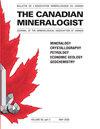Experimental fluid-mediated alteration of zircon under lower greenschist facies conditions
IF 1.5
4区 地球科学
Q3 MINERALOGY
引用次数: 4
Abstract
The use of zircon in the dating of geological processes and tectonic events has become a standard approach in many aspects of Earth science research. As a result, understanding how zircon interacts with aqueous fluids during metasomatism has become increasingly important. The alteration of natural zircon is driven primarily by coupled dissolution–reprecipitation or by ion-exchange with an aqueous fluid. In this study, whole and intact, euhedral light-brown zircon crystals (100–250 μm in length; 2 mg) from the Oligocene Fish Canyon Tuff (FCT) were experimentally reacted with an alkali-bearing reactive fluid and a REE + P source (0.5 mg CePO4 or 0.5 mg YPO4). Experiments were conducted in sealed Au metal capsules at 350 °C and 100 MPa for 182 days. During the experiment, the zircon became colorless, indicating annealing of the radiation damage in the crystal. Two-dimensional element maps of the outermost 3 μm of unpolished zircon crystal surfaces were produced using a grind of contiguous 7 μm analytical spots via laser ablation inductively coupled plasma mass spectrometry (LA-ICP-MS). The chemical maps indicate that the surface of the zircon crystals from each experiment heterogeneously reacted with the fluid, such that the Ce and Y concentration of chemically modified areas increased (by an order of magnitude) in the CePO4-bearing and YPO4-bearing experiments, respectively, when compared with the chemical maps of unaltered zircon grain surfaces. Helium ion microscopy of polished crystals revealed discontinuous micron-scale altered domains at the crystal margin, consistent with the findings of the unpolished mapping technique. Interestingly, the Th and U concentration of the altered zircon grain surfaces were consistent with the unaltered zircon regardless of the experiment. Incorporation of REEs on the zircon grain surface likely occurred via the coupled substitution REE3+ + P5+ ↔ Zr4+ + Si4+. The results from these experiments imply that the surfaces of minimally metamict zircon can be chemically modified by alkali-bearing fluids via ion exchange under lower greenschist pressures and temperatures over relatively short time periods with respect to the geological time scale.低绿片岩相条件下锆石的实验流体介导蚀变
在地质过程和构造事件的年代测定中使用锆石已成为地球科学研究许多方面的标准方法。因此,了解锆石在交代作用过程中如何与含水流体相互作用变得越来越重要。天然锆石的蚀变主要是由耦合溶解-再沉淀或与水性流体的离子交换驱动的。在本研究中,来自渐新世Fish Canyon Tuff(FCT)的完整、完整的自形浅棕色锆石晶体(长度100–250μm;2 mg)与含碱反应流体和REE+P源(0.5 mg CePO4或0.5 mg YPO4)进行了实验反应。实验在密封的Au金属胶囊中在350°C和100MPa下进行182天。在实验过程中,锆石变为无色,表明晶体中的辐射损伤已经退火。使用激光烧蚀电感耦合等离子体质谱法(LA-ICP-MS)研磨连续的7μm分析点,生成最外层3μm未抛光锆石晶体表面的二维元素图。化学图谱表明,来自每个实验的锆石晶体的表面与流体发生非均匀反应,使得与未改变的锆石晶粒表面的化学图谱相比,在含CePO4和含YPO4的实验中,化学改性区域的Ce和Y浓度分别增加(一个数量级)。抛光晶体的氦离子显微镜显示,晶体边缘存在不连续的微米级蚀变畴,这与未抛光映射技术的发现一致。有趣的是,无论实验如何,改变的锆石颗粒表面的Th和U浓度都与未改变的锆石一致。REE在锆石颗粒表面的结合可能是通过耦合取代REE3++P5+发生的↔ Zr4++Si4+。这些实验的结果表明,相对于地质时间尺度,在较低的绿片岩压力和温度下,含碱流体可以在相对较短的时间内通过离子交换对最小变质锆石的表面进行化学改性。
本文章由计算机程序翻译,如有差异,请以英文原文为准。
求助全文
约1分钟内获得全文
求助全文
来源期刊

Canadian Mineralogist
地学-矿物学
CiteScore
2.20
自引率
22.20%
发文量
45
审稿时长
4-8 weeks
期刊介绍:
Since 1962, The Canadian Mineralogist has published papers dealing with all aspects of mineralogy, crystallography, petrology, economic geology, geochemistry, and applied mineralogy.
 求助内容:
求助内容: 应助结果提醒方式:
应助结果提醒方式:


